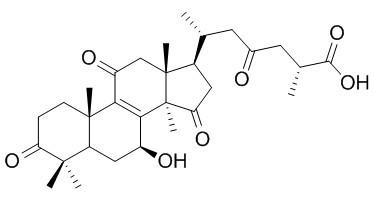Ganoderic acid C1
Ganoderic acid C1 has anti-inflammatory activity, has potential for treating TNF-α mediated inflammation in asthma and other inflammatory diseases. Ganoderic acid C1 has anti-tumor-promoting activity. It is moderately active inhibitors against HIV-1 protease.
Inquire / Order:
manager@chemfaces.com
Technical Inquiries:
service@chemfaces.com
Tel:
+86-27-84237783
Fax:
+86-27-84254680
Address:
1 Building, No. 83, CheCheng Rd., Wuhan Economic and Technological Development Zone, Wuhan, Hubei 430056, PRC
Providing storage is as stated on the product vial and the vial is kept tightly sealed, the product can be stored for up to
24 months(2-8C).
Wherever possible, you should prepare and use solutions on the same day. However, if you need to make up stock solutions in advance, we recommend that you store the solution as aliquots in tightly sealed vials at -20C. Generally, these will be useable for up to two weeks. Before use, and prior to opening the vial we recommend that you allow your product to equilibrate to room temperature for at least 1 hour.
Need more advice on solubility, usage and handling? Please email to: service@chemfaces.com
The packaging of the product may have turned upside down during transportation, resulting in the natural compounds adhering to the neck or cap of the vial. take the vial out of its packaging and gently shake to let the compounds fall to the bottom of the vial. for liquid products, centrifuge at 200-500 RPM to gather the liquid at the bottom of the vial. try to avoid loss or contamination during handling.
Korean J. Medicinal Crop Sci.2018, 26(2):148-156
Am J Chin Med.2016, 44(6):1255-1271
Phytochemistry Letters2015, 243-247
Anticancer Res.2022, 42(9):4403-4410.
Front Pharmacol.2016, 7:460
Heliyon.2023, 9(12):e22932.
Evid Based Complement Alternat Med.2017, 2017:1401279
Processes2024, 12(8), 1563
South African Journal of Botany2024, 168:209-220.
Pharmaceuticals (Basel).2024, 17(10):1368.
Related and Featured Products
Inflamm Bowel Dis. 2015 May 19.
Anti-inflammatory Effects of Ganoderma lucidum Triterpenoid in Human Crohn's Disease Associated with Downregulation of NF-κB Signaling.[Pubmed:
25993687]
METHODS AND RESULTS:
Triterpene Ganoderic acid C1 (GAC1) was isolated from G. lucidum. Stimulated RAW 264.7 macrophages were treated with Ganoderic acid C1. Human PBMCs and colonic biopsies were obtained from children with CD and cultured with or without Ganoderic acid C1. TNF-α and other proinflammatory cytokine levels were measured in the culture supernatant. NF-κB signaling was investigated in PBMCs and colonic mucosa treated with Ganoderic acid C1 by In-Cell Western and Western blot analysis. GAC1 decreased TNF-α production by macrophages and PBMCs from CD subjects. Ganoderic acid C1 significantly decreased TNF-α, IFN-γ, and IL-17A production by inflamed colonic biopsies from CD subjects. These effects were due to downregulation of the NF-κB signaling pathway.
CONCLUSIONS:
Ganoderic acid C1 inhibited production of TNF-α and other proinflammatory cytokines by PBMCs and inflamed CD colonic mucosa due to blockage of NF-κB activation. Ganoderic acid C1 is a key beneficial constituent in G. lucidum and the Food Allergy Herbal Formula-2 in suppressing the inflammatory cytokines found in CD and warrants clinical investigation for the treatment of CD.
Int Immunopharmacol. 2015 May 21.
Ganoderic acid C1 isolated from the anti-asthma formula, ASHMI™ suppresses TNF-α production by mouse macrophages and peripheral blood mononuclear cells from asthma patients.[Pubmed:
26004313]
Asthma is a heterogeneous airway inflammatory disease, which is associated with Th2 cytokine-driven inflammation and non-Th2, TNF-α mediated inflammation.
Unlike Th2 mediated inflammation, TNF-α mediated asthma inflammation is generally insensitive to inhaled corticosteroids (ICS). ASHMITM, aqueous extract of three medicinal herbs-Ganoderma lucidum (G. lucidum), Sophora flavescens Ait (S. flavescens) and Glycyrrhiza uralensis Fischer (G. uralensis), showed a high safety profile and was clinically beneficial in asthma patients. It also suppresses both Th2 and TNF-α associated inflammation in murine asthma models. We previously determined that G. uralensis flavonoids are the key active compounds responsible for ASHMITM suppression of Th2 mediated inflammation. Until now, there are limited studies on anti-TNF-α compounds presented in ASHMITM.
METHODS AND RESULTS:
The objective of this study was to isolate and identify TNF-α inhibitory compounds in ASHMITM. Here we report that G. lucidum, but not the other two herbal extracts, S. flavescens or G. uralensis inhibited TNF-α production by murine macrophages; and that the methylene chloride (MC)-triterpenoid-enriched fraction, but not the polysaccharide-enriched fraction, contained the inhibitory compounds. Of the 15 triterpenoids isolated from the MC fraction, only Ganoderic acid C1 (GAC1) significantly reduced TNF-α production by murine macrophages (RAW 264.7 cells) and peripheral blood mononuclear cells (PBMCs) from asthma patients. Inhibition was associated with down-regulation of NF-κB expression, and partial suppression of MAPK and AP-1 signaling pathways.
CONCLUSIONS:
Ganoderic acid C1 may have potential for treating TNF-α mediated inflammation in asthma and other inflammatory diseases.



